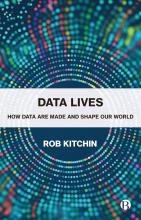
As we become more swaddled by data in our everyday lives, it becomes almost impossible to fully comprehend data's impact and potential outcomes in the future. In Data Lives, Rob Kitchin takes a novel approach to examine a complex topic that is data. Instead of choosing a traditional academic writing style, Kitchin blends fictional and personal stories to explain how data are produced, processed, and interpreted, as well as the consequences of these actions. Through storytelling, the author aims to make readers relate to these experiences at the same time that he dares them to question our datafied world.
In chapter 1, "Data Stories," Kitchin presents a summary of how we found ourselves living in a data-driven world that has eroded our faith and trust in governments and companies due to the opaqueness of how data are used. The author presents us with the concept of "cooking of data" in order to make us comprehend how human values, desires, and social relations impact the use of data and how this use can not only empower but also exploit, discriminate against, and persecute individuals (5–6). Kitchin demonstrates that by understanding that data and data systems are never raw but instead always cooked (5), it is possible to challenge the "mantra of data revolution" (6) and contest unjust outcomes.
Part 2, "The Life of Data," starts with a mix of fictional stories and real-life inputs by the author that follow the reader until the last section of the book. Although the stories have different subjects, they all have a long arc of argument that unites them: teaching readers the basics of data.
The first sections demonstrate how processes of extraction, abstraction, generalization, and sampling in data can introduce error, noise, imprecision, and bias and that knowing this information is essential to end the fairy tale that data are neutral and can be trusted blindly (41). By sharing his personal experiences, Kitchin dives into other technical aspects of data such as fragmentation and harmonization, through a series of different examples. He also enlightens readers on how data standardization initiatives are essential to avoid a "Data Tower of Babel" and why they are central in enabling territorial politics and systems of governance.
The succeeding sections address the topic of open data. Through fictional stories, the author sheds a light on how some governments still fight against open data by holding back funding, although open data can be considered a great benefit to society, enabling the involvement of other key actors to participate in projects. For Kitchin, this involvement can change the outcome of the "politics of building civic tech" (69). By understanding [End Page 121] that data are not neutral, value-free, or nonideological, it becomes possible to allow other stakeholders to have a say on how these data are "cooked" to their benefit (78). In the next chapter, the author contrasts the open data vision by presenting us with the reality of massive data silos held by data-driven organizations that are used for profit and held indefinitely.
Part 3, "Living with Data," starts with one of the most interesting chapters of the book, "Traces and Shadows," in which Kitchin takes the reader through a journey of his life with data, both working with and being impacted personally by data. This journey makes us identify with how our own lives are impacted by data and reflect on the surveillance capitalism we live in (118). This is the first step into the next chapters, which are fictional stories that show how data are embedded in everyday actions. Watching a recommended movie on a streaming service and following health recommendations from an activity tracker are, for Kitchin, examples of how "scopophilic technologies" (131) manipulate pleasure hormones in our brains. All of these examples demonstrate how we quantify and self-generate data about our lives and provide private companies with data that they would not otherwise be able to get.
The next chapter sheds a light on the dark side of data: the noncontextualized metrics that impose performance indicators promising productivity and performance enhancement but that instead deliver narrow, biased patterns of behavior. The outcomes of metrics provide policymakers with biased data that ignore the nuances of the real world, as is exemplified by the story of an unemployed firefighter who failed to keep up with state metrics to earn benefits. Yet Kitchin provides us the light at the end of the tunnel by indicating how more engaged, nuanced forms of management result in less stressed and more productive workers.
The last chapter centers around how cities have become a "security theatre" (169), transforming citizens into datafied individuals, similar to guinea pigs in a laboratory experiment (153). Through sensors, every movement and action in cities is monitored with the promise of providing better administration services while instead delivering surveillance and nonrepresentation. In this context, in the chapter "Data for the People, by the People" the author expresses how data are not able to magically solve chronic problems. Instead, it is necessary to implement "technological sovereignty," empowering individuals to redistribute the power of data to their benefit (193).
In part 4 Kitchin situates the COVID-19 pandemic as an event that exemplifies the core concepts of his book, demonstrating how decisions that impacted the world were based solely on data that were sometimes biased by underlying political intentions.
In Data Lives Rob Kitchin dares the reader to question and demand better data solutions from companies and governments. This book is very relevant to both academic and nonacademic audiences, and it makes complex topics relatable to readers' everyday lives without underestimating their technical aspects. [End Page 122]
—Barbara Lazarotto, Vrije Universiteit Brussel

